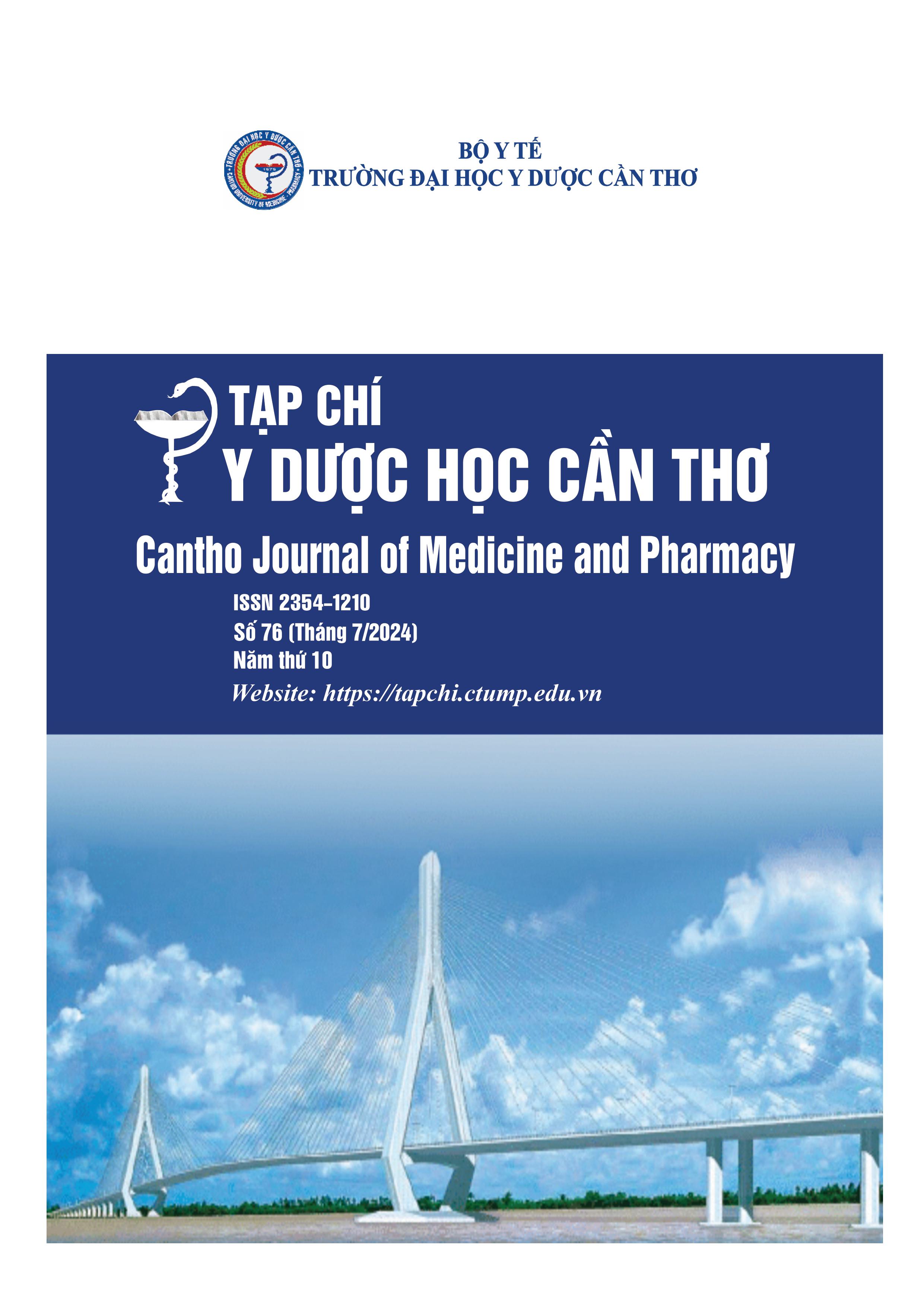STUDY ON CLINICAL AND TREATMENT RESULTS OF SPINAL LUMBAR SPONDYLOLISTHESIS OF POSTERIOR LUMBAR INTERBODY FUSION AT CAN THO CENTRAL GENERAL HOSPITAL
Main Article Content
Abstract
Background: Posterior lumbar interbody fusion provides excellent nerve decompression surgery, creating stability and firmness for the spine. In Vietnam, there have not been many studies to evaluate the treatment effectiveness of this method. Objects: To evaluate the results of surgical treatment for lumbar spondylolisthesis by posterior lumbar interbody fusion in Can Tho Central General Hospital. Materials and methods: A descriptive, prospective study on 49 patients diagnosed with lumbar spondylolisthesis. Visual Analogue Scale, Oswestry Disability Index, before surgery and 6 months after surgery were collected and compared. Bone fusion was evaluated by CT Scanner at 6 months after surgery, according to Bridwell standards. Intraoperative and postoperative complications will be recorded and analyzed. Results: After 6 months, the VAS score in the back decreased from 6.49 ± 1.34 to 2.84 ± 1.58 and the VAS score in the leg decreased from 6.22 ± 1.53 to 1.78 ± 1.23. ODI decreased from 51.7 ± 13.0% to 13.9 ± 8.6%, this decrease was statistically significant (p < 0.001). The bone fusion rate reached 89.8% 6 months after surgery, and the treatment results of good and very good according to MacNab were 79.6%. Complications of foot arch rupture 2%; 4% nerve root damage, fully recovered 6 months after surgery. Conclusions: Posterior lumbar interbody fusion is a safe and effective method in treating lumbar spondylolisthesis, achieving high bone fusion rates, good neurological function recovery and low complications.
Article Details
Keywords
Lumbar instability, posterior lumbar interbody
References
2. Lemoine T et al. The prevalence of lumbar spondylolysis in young children: a retrospective analysis using CT. Eur Spine J. 2018. 27(5),1067-1072, doi: 10.1007/s00586-017-5339-5.
3. Audat ZM, Darwish FT et al. Surgical management of low grade is thmic spondylolisthesis; a randomized controlled study of the surgical fixation with and without reduction. Scoliosis. 2011.6(1), 14, doi: 10.1186/1748-7161-6-14.
4. Mummaneni PV et al. Minimally invasive versus open fusion for Grade I degenerative lumbar spondylolisthesis: analysis of the Quality Outcomes Database. Neurosurg Focus. 2017. 43(2), E11, doi: 10.3171/2017.5.FOCUS17188. PMID: 28760035.
5. Nguyễn Đạt Hiếu và cộng sự. Kết quả phẫu thuật trượt đốt sống vùng thắt lưng tại Bệnh viện ĐA khoa tỉnh Hòa Bình. Luận án chuyên khoa II. Đại học Y khoa Hà Nội. 2020.
6. Nguyễn Vũ. Nghiên cứu điều trị trượt đốt sống thắt lưng bằng phương pháp cố định cột sống qua cuống kết hợp hàn xương liên thân đốt. Luận án Tiến sĩ Y học. Đại học Y khoa Hà Nội.
7. Hoàng Gia Du, Nguyễn Hoàng Đức. Đặc điểm lâm sàng, chẩn đoán hình ảnh bệnh nhân trượt đốt sống được phẫu thuật bằng phương pháp PLIF/TLIF có hỗ trợ O.ARM. Tạp chí Y học Việt Nam. 2022. 514(2), 28-33. https://doi.org/10.51298/vmj.v514i2.2587.
8. Dennison EM. Osteoarthritis: The importance of hormonal status in midlife women. Maturitas. 2022. 165, 8-11. doi: 10.1016/j.maturitas.2022.07.002.
9. Vanti C, Ferrari S, Guccione AA, Pillastrini P. Lumbar spondylolisthesis: STATE of the art on assessment and conservative treatment. Arch Physiother. 2021. 11(1),19, doi:10.1186/s40945021-00113-2.
10. Nguyễn Khắc Linh và cộng sự. Đánh giá kết quả phẫu thuật trượt đốt sống thắt lưng do thoái hóa bằng kỹ thuật bắt vít qua cuống và ghép xương sau bên. Tạp chí Y Dược học Quân sự. 2020. 8, 81-86.
11. Li R, Fu D, Han H, Zhan Z, Wu Y, Meng B. Comparative analysis of percutaneous endoscopic interlaminar discectomy for highly downward-migrated disc herniation. J Orthop Surg Res.
2023.18(1):602. doi: 10.1186/s13018-023-04090-z.


